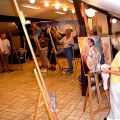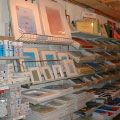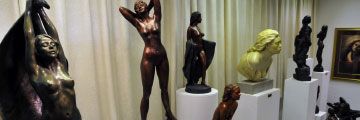April 9th represents the beginning of a new chapter in the Norwegian history. At 04.21 p.m. the dramatic order "Open fire" was given by the commanding officer of the Oscarsborg fortress. This order meant the stopping of a German armada consisting of three cruisers and a number of smaller battleships and further on the sinking of the "unsinkable" battleship "Blücher". In giving the King, Government and Parliament the opportunity to escape from Oslo as well as letting the authorities rescue the federal gold reserves, this battle had an essential impact on the events that were follow during the next five years.
4.21 a.m. - Colonel Birger Kristian Eriksen gives his command "Open fire".
Commanding officer at the main battery, sergeant Rækken carries out the order. The grenade from "Moses" hits the ship above the bridge in the centre of command for the air defence.

2nd artillery officer, Lieutenant Hans Erich Pochhammer, and several private soldiers nearby were killed. The commanding officer of the air defence, Lieutenant-Colonel Schürd and several others were severely injured. Almost the whole crew of the centre of command for air defence were killed immediately.
2nd Cannon - Officer in command, sergeant Strøm, gives the order "Open Fire".
The 345 kg grenade from Aron hits the aircraft hangar on Blücher and immediately sets the aeroplanes on fire.
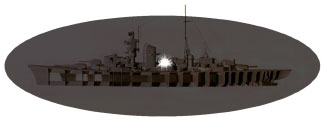
Both aircrafts, the one which stood ready for takeoff on the catapult sledge as well as the one in the hangar, were soon covered by the flames which reached the tower. The strike also put the 10.5cm cannon (no. 3) on the port side of the vessel out of action. Even though the grenade from "Moses" probably never did explode, both shots had severe impact and were of great importance to the sinking of Blücher.
4.21 a.m. - SECTION IV and IX
The first shot from Moses was to be the signal to the artilleries at Kopås, Husvik and Seiersten on the east bank of the fjord as well as for the artillery at Nesset on the west bank.

Captain Vang Jul Enger was in command at Kopås and had three 15cm cannons at his disposal. Lieutenant Rolf Bertelsen at Husvik had two 57mm cannons. Lieutenant Hans Solli at Seiersten had two 40mm machinecannons and three 7.92mm machine-guns. Lieutenant Strand at Nesset had three 57mm cannons. The heaviest impact from the bombardment was on the port side of the ship.
4.30 a.m.
The torpedo battery at Nordre Kaholmen launches two Whitehead torpedoes and gives the "unsinkable" cruiser its final stroke.
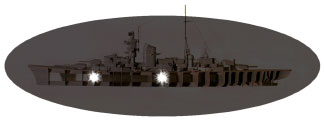
In the underwater torpedobunker the retired officer, commander Andreas Anderssen had made the 40 years old, but recently renewed Whitehead torpedoes ready. Alongside are lieutenant A. Karlsen, miner S. M. Bexrud and eight private soldiers.
They decide that their twelve torpedoes should be divided to cover six ships. Due to this Blücher only got two torpedoes.
6.22 a.m. - Blücher sinks
4.40 a.m. In the hope of saving men and ships, the anchors were dropped nearby Askholmene. The crew continued its struggle against the fire, but with no success. In order to avoid further explosions Blüchers own torpedoes were shot out and exploded against the rocks on both sides of the fjord. 5.30 a.m. The crew is given orders to abandon the ship, but as Blücher sinks 50 minutes later a large number of them are still on board. Many froze to death in the cold water and others were burnt to death by the flaming oil.
All together about 1000 German soldiers and sailors lost their lives in this event. About 1400 were able to rescue themselves on east bank of the fjord. (Two civilians were killed from grenades falling down in Drøbak.) For the next ten hours Oscarsborg was heavily bombed. 42 aeroplanes attacked, dropping hundreds of bombs. Even after this there were no Norwegian casualties. This act of defence gave the King, Government and Parliament the opportunity to escape from Oslo and the authorities were able to rescue the federal gold reserves.
OSCARSBORG
Three 28 cm. cannons (only Moses and Aron were put into action)
TORPEDO BATTERY
3 torpedo tubes with 12 torpedoes (2 were launched)
KOPÅS BATTERY
Three 15 cm. cannons
HUSVIK BATTERY
Two 57 mm. cannons
SEIERSTEN BATTERY
Two 40 mm. machinecannons and three 7,92 mm. machineguns
NESSET
Three 57 mm. cannons

